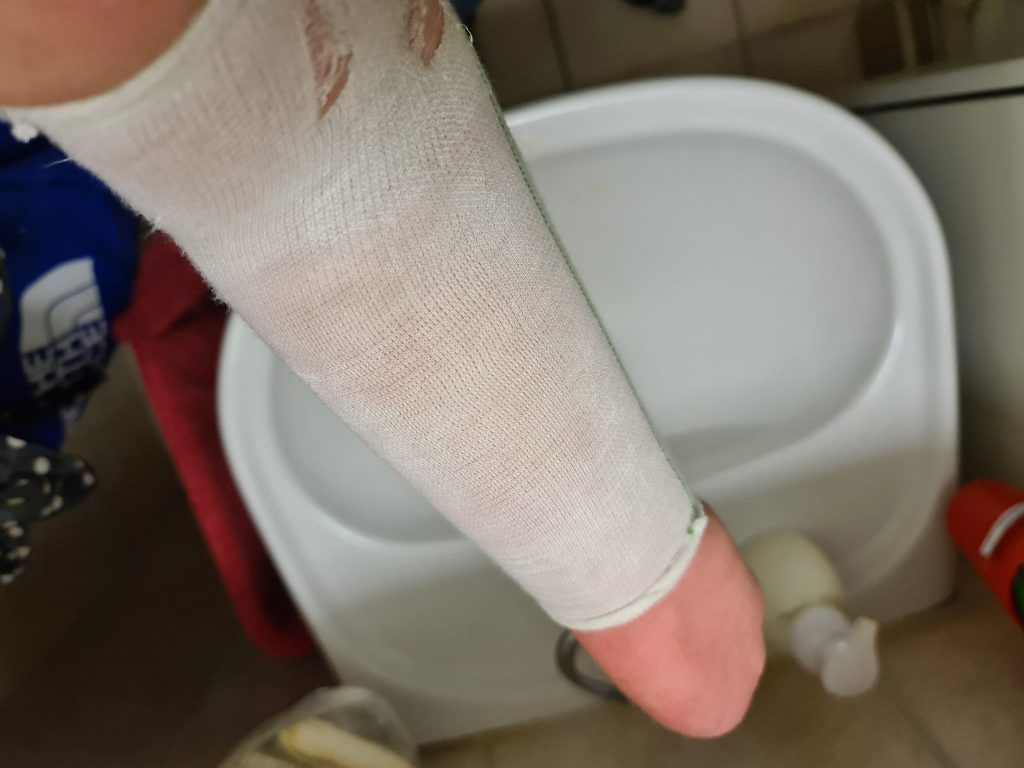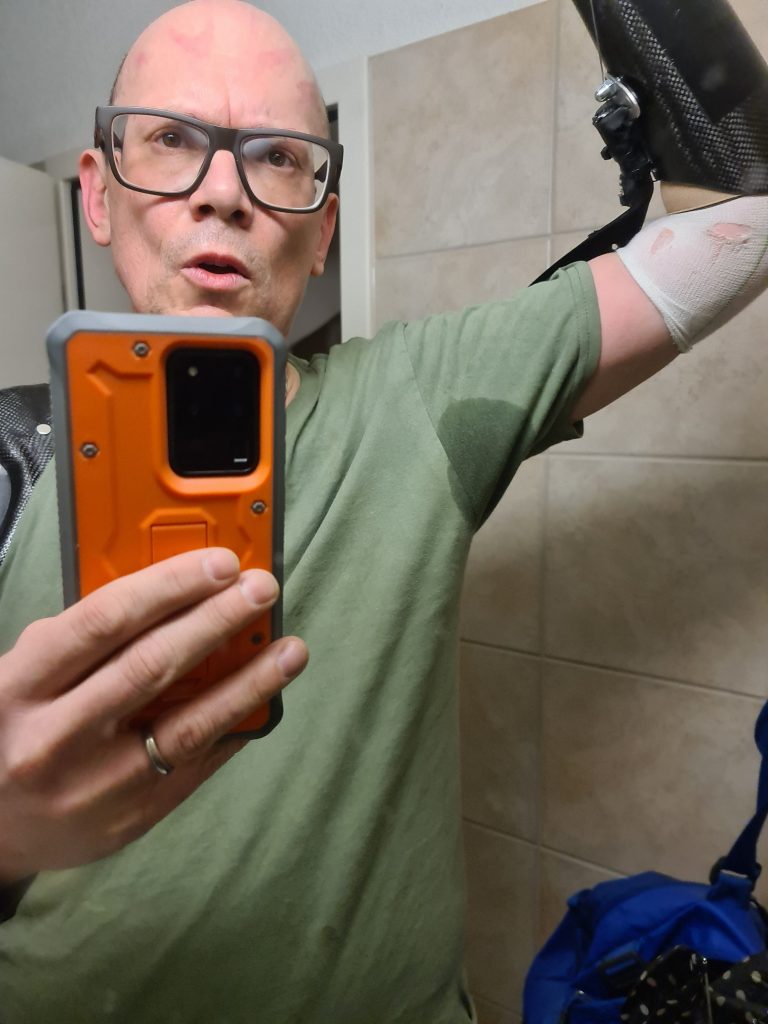Sweat may, can and eventually will be an issue for myoelectric control, where not only does the socket or suspension risks to really chafe up the stump skin, but also, control may be lost at some point. Really this can be so uncomfortable that you may not want to wear a myoelectric arm again.
Boo hoo, big deal, who cares about a tad bit of humid skin, right?
So you will think that I am a snowflake, and start thinking things like “suck it up, buttercup” – and I am all with you on that, really, I am.
Let us compare notes then! Here is my arm after wearing an iLimb (myoelectric, “bionic”) for one (1) day at the office for only light work there [details: link]:
From where I am standing, there are blisters and abrasions there, and a rash. Boo hoo, sure, big deal? You tell me, I cannot wear the prosthesis for a few days after that, if you want to know whether those are a few more days where I am forced to learn how to live life without prosthesis, you may very well think that but why would I comment ; )
Sweat usually is also an issue for other prosthesis – cosmetic, body-powered -, as, no matter what, one risks friction and sweat rashes under the liner if one does not know how to go about this [link].
To be honest, the subject is as irritating as it is relevant, as ubiquitous as it is painful, as irritating as it is uncomfortable as it is constantly ignored by academic/university researchers that study the field of prosthetic arms. The problem there also is that many arm amputees explicitly do not want invasive surgery – not for suspension (osseointegration), not as itch relief – also because surgery of that kind seems only to increase the overall burden of suffering and expenses.
If you have a problem with this statement – and you very well may, I give you that, we could include a table of the 30 most often cited prosthetic arm researchers and see (a) how many articles of them focused on sweat in the light of sockets and liners, and (b) how many articles they did write, and what these really were. Yes, why not.
Sweat in everyday life: it exists in large amounts, and where that is, there is more.
Sweat is generated in ample, large, sufficient amounts when doing real work or riding bicycle – it is not imaginary or potential, much rather, it is very real
I never figure it’d be interesting to others. But the overlap of relevance and existence in real life and a comprehensive absence of the term sweat in research makes this a step that becomes necessary: show sweat to others.
A selfie, of a kind that I rarely take, immediately after a work deployment where we had gone in with protective suits.
Shirt and undershirt dripping wet under arms and across collar, chest and belly.
Even after “just” a “short” bicycle ride home, the prosthesis as well as the rest of me is, well, sweaty.
Photo of under liner / liner liner / tube gauze: that and arm stump are all wet
I did mention, wet from sweat, right? This is after a bike ride.
It is a reality. When it accumulates inside the prosthesis, I will stop riding bike and pour the sweat out. That is how that works.
Working at work related deployment June 2021
12.34 hours that day
after the subsequent deployment 13:39 h
So, sweating all the way through.
After a few days of bike holidays with a normal mountain bike, here is the salt crust:
Sweating is as ubiquitous and mundane, as profane and as real as things ever can be. To ignore the profuse amounts of sweat generated by what in essence is life equates an inability to build a prosthetic arm. You want the device to excel while real life happens, that is what you want.
But that is not where it ends. Sweat is also part during everyday life for office workers.
- Myoelectric prostheses can be really damaging to stump skin:
- My arm got all chafed up when I used my myoelectric prosthesis for light office work, and there were blisters and rashes and abrasions, a bit uncomfortable [link].
- Also when not riding bike so hard that I really sweat, skin humidity seems to facilitate what we believe to be electrochemical skin burns [link].
- Other people report function issues with sweat and myoelectric control [link]:
- (…) “Once sweat on my stump started the wrist motor rotating while I was in line at a register trying to pay. I had to remove the battery from the socket to stop the erroneous movement. People really made a big detour around me after that. ” (…)
- (…) “I had a business meeting one day, and while I got a bit of an attack against me by the supervisor, and I got nervous and sweating, my prosthetic arm would start acting out stuff all by itself. ” (…)
What do do?
-
- You are lost? Use an algorithm to find out what prosthesis is best for you [link]. Thereby, the myoelectric, 3D-printed [link] or cosmetic arms are basically junk, and the body-powered arm wins [link].

- You want to invest or build and sell these? Then I put together a list of things to consider for you [link]. There are considerations of what part of the population may be best equipped to handle stress without generating sweat [link].
- You are wearing a body-powered arm yourself? Try this stuff [link].
- You are lost? Use an algorithm to find out what prosthesis is best for you [link]. Thereby, the myoelectric, 3D-printed [link] or cosmetic arms are basically junk, and the body-powered arm wins [link].








